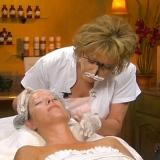Chemical Peels: What is Fact and Fiction

I consider acid peeling more than just a science; it’s an art form. As such, learning an art evolves with understanding and experience. Anyone who knows me knows how passionate I am about the results skin peels produce.
I have watched that same passion and enthusiasm bloom in skin care professionals as they get deeper into art of skin peeling. Naturally however, there is some trepidation when it comes to peels, much of which stems from the many myths surrounding the process. Today’s post will aim to disprove some of those misnomers so you are better equipped to talk to clients about it.
Myth: Chemical peels result in scarring and raw skin
Truth: If a trained skin care professional performs the peel, permanent scarring will not be an issue. Redness and peeling are normal with deeper peels, but today there are numerous superficial options available as well as advancements in cosmeceutical formulas that reduce inflammation and rebuild and heal the skin. The long-term effects of the peels are healthier, smoother, more youthful-appearing skin.
Myth: Only one treatment is needed
Truth: Typically several applications must be administered over several months or years, depending on the skin damage. As the skin care professional, it’s up to you assess and determine what is best for your client’s skin.
Myth: Chemical peels don’t mix with rosacea, pigmented or higher Fitzpatrick skin types
Truth: As I mentioned there are various levels of chemical peels. The superficial treatments I use follow three designations of intensity including, progressive, mid-depth and deep. Most skin types, including those with pigmentation issues or darker skin respond well to progressive treatments. In fact, peels can have a very positive effect. Acid blends like 10 percent TCA, 20 percent lactic and salicylic, along with L-ascorbic and azelaic, work well with these skin types.
Now that you know a few myths and their truths, do’s and don’ts of chemical peels are always worth a visit:
- Do undergo appropriate training – this is very important
- Do a complete skin assessment and skin history on the client
- Do perform a patch test at least 48 hours before treatment
- Do send clients home with care instructions
- Do take before-and-after photos to track progress
- Do manage expectations prior to starting a program
- Never do a peel on the first visit
- Never perform a peel on a client using Retin-A or taking Accutane
- Never conduct a peel if a client has received Botox or another injectable procedure that day
Skin peels can deliver considerable improvements, but the success of a peel depends on four things: your knowledge, selecting fresh quality ingredients to work with, your ability to read the skin, and client compliance.
Question: What is your favorite peel treatment to perform?
